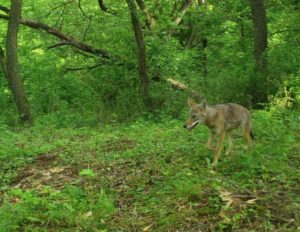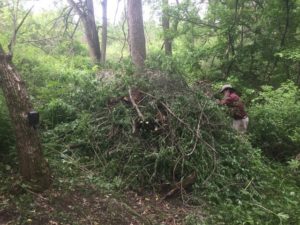
Snapshot Wisconsin: Candid Camera for Critters
Doug and I have been taking care of our 44 acres since 2003, and I still find myself getting a chill to realize that I am standing on ground where I have never stood before. The ravine that cuts through the center of our land is the kind of steep and rugged terrain that has resisted our exploration.
We have traced the top edges on the north and south with foot paths and look across it in winter, but in summer the ravine is so filled with leafed-out trees and invasive underbrush that it is visually impenetrable and thornily daunting, though I know the deer and turkeys and other wildlife move through it freely on barely visible trails. It’s their inner sanctum, and we leave it to them.
Now, thanks to Snapshot Wisconsin, we will soon be glimpsing some of that furtive to and fro with a trail camera supplied by the program. And the information we supply the Wisconsin Department of Natural Resources (DNR) will help conservation professionals determine population densities and species distributions.
Snapshot Wisconsin

The Department of Forest and Wildlife Ecology has partnered with the Wisconsin DNR in this statewide Snapshot initiative to gather a lot more info, and also involve the public in monitoring these motion-activated trailcams. This is a great example of the ways that citizen science is starting to change the way data is gathered and policies are determined.
The state has been subdivided into 6,273 blocks for cameras – about 4 per township. As of last April, there were about a thousand cameras deployed.
We’re told that our trail camera may capture thousands of images each month. The Snapshot program has collected over 18 million photos of wildlife quietly going about their business since the program began in 2015. This data is increasing the accuracy of wildlife population estimates. For example, better fawn to doe ratios help determine whether the deer population is growing or shrinking. These citizen-monitored cameras increase coverage and cut costs by reducing the need for aerial surveys. Also collecting info this way is safer for both wildlife and technicians when compared to bait and trap alternatives.

The camera is motion activated and takes 3 quick photos. Having three views can really make it easier to ID in some cases. And at 10:40 every day, the cameras take a time lapse photo that goes to the University of Wisconsin for season monitoring. The photos on the photo card are encrypted, so that we can’t view them until we have downloaded them to the DNR, where they are de-encrypted and any photos of humans are deleted for privacy. Then Snapshot will returned the photos to us, and we can look at them and ID them for the program if we wish to.
Doug and I spent several snow-covered days of the early spring scouting for places where animal tracks seemed most active. Not surprisingly, our most productive search led down into the ravine. Fighting our way back there on a late spring day to clear an area and deploy the camera, we found ourselves in a seriously overgrown but magical spot that we had never visited when the world is green.

The brush pile we created which 1. cleared the camera viewing area and 2. may create new habitat. To make sure the camera is not activated every time a twig blows in a breeze, we had to clear the area in front of the camera. Several hot, sweaty hours later, the tiny clearing which made me want to bring a camp chair and just sit there all day, but that would be counterproductive to snapping wildlife. I find myself pausing to think about that spot and smiling often.
So this is going to be one of those win/win situations. We have been prompted to set up a trail cam to get a non-intrusive glimpse of some of our wildlife neighbors AND the professionals who are dedicating their lives to understanding and managing that same wildlife statewide will have more accurate data to make better decisions.

Go to Snapshot Wisconsin to learn more about getting involved in this great program.
Written by Denise Thornton, Driftless Landowner and Environmental Blogger for digginginthedriftless.com.
